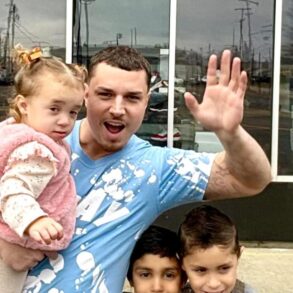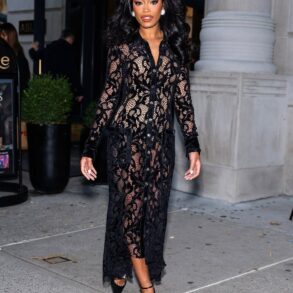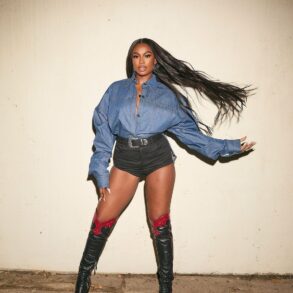
When Olympia Gayot greets me at the Manhattan high-rise that houses J.Crew’s headquarters, she’s wearing a modern, slim-fitting, broad-shouldered pinstripe suit, her signature blonde curls stretching down her back. She hands me a copy of Casa Vogue from the ’90s. It’s one of her favorites. On a wall across from her desk, Gayot has hung a collage of vintage images, like one of an ornate sink that inspired her and a solitary chair draped with a stray shirt. She points to a distant photo of a woman alone on a beach. This one is new, part of a recent J.Crew campaign. “I just love this image even though you don’t really see the clothes,” she says. “It’s not about that; it’s about the sensibility.”
That sensibility is what Gayot has been cultivating since her appointment as womenswear director of J.Crew in 2020. She has played a pivotal role in reviving the once-loved brand and pulling it out of a period of bland monotony. It has become a well-documented, much-discussed fact that the label is so very back. Gayot has tapped into the tried-and-true formula for brand gold: pulling of-the-moment celebrities like Florence Pugh, Julianne Moore, Ayo Edebiri, and Sadie Sink into campaigns; leaning into pastimes and cultural touchstones that are coming back into prominence, like the ballet and a subsequent collaboration with the New York City Ballet; and giving consumers the next trend in the fashion Zeitgeist just before they even know of it (think pops of red, kitten heels, stripped-down women’s suiting). But something Gayot has done especially well that has played a hand in invigorating a heritage brand, especially one with traditional roots like J.Crew, is the simple act of looking backward.
Much of J.Crew’s new crop of designs under Gayot involves some sentiment — a feeling that we’ve been here before or, at the very least, worn these clothes. The brand’s holiday accessories edit was filled with nostalgic styles like ballet flats, slingbacks, an updated version of a loafer, plastic headbands, women in ties, and pearls adorned with bows. J.Crew’s campaign for their newest cashmere launch was shot entirely on film, and while the clothes were new, the images felt like frames suspended in the past.
“I think we’re all attracted to nostalgia and memory,” Gayot says. “Like the nostalgia of old catalogues for the brand, just like the memories you have from childhood. How do you make that new again?”
Next to a chair in her office, a stack of old J.Crew catalogues sits with tiny sticky notes jutting out from the pages. It’s a set of classic magazines, ones that seemed to sell both products and a lifestyle — one that was outdoorsy, laid-back yet upscale, and affluent. These catalogues from the ’90s include cover stars like Linda Evangelista and Amber Valletta, idolized women in idyllic settings. Today, Gayot is letting me browse through them along with her and ask my most curious questions on my quest to discover whether history really should repeat itself. Read on as we go back in time with J.Crew.


What’s so interesting about old things to you?
For me, it’s capturing nostalgia. If something stood the test of time, that’s what makes it great. A leather jacket that looked cool 20 years ago also looked cool 40 years ago and still looks cool today.
Do you have a memory of the first old thing you got?
I collected Victorian dresses for many years in my 20s. That was my thing. There was a girl who sold them on the street outside the Mercer. She would hand-dye them these beautiful pale colors, like mint and pale pink. I would wear those with army boots.
Do you consider yourself a collector?
Definitely. I love new, too, though. I feel like what’s going on in fashion right now is exciting. It’s just about the mixing because you always have to move forward in fashion. That’s what’s so inspiring about it. It’s that combination of looking back and looking forward and then finding something that feels right for now.


What are you excited about that’s new?
I love living in New York. I love walking around and seeing what people are wearing. New York is so amazing like that because people just come here and they express themselves. That joy of self-expression is very exciting to me. So I just observe because when you’re a designer, you have to have all your feelers out.
Is there a period you revisit the most?
I’m playing with the brand’s heritage from the ’80s and ’90s. There was such a moment around that simplicity and that worn-in look: the feeling, the catalogues, the clothes, all of it.
But in general, I love the ’70s. I love that rock-and-roll ’70s vibe.


Do you have a favorite vintage J.Crew catalogue or archival image?
The Linda Evangelista one’s insane. It’s so modern, too. The crazy part is that that picture could be taken today. The shirt is just a chambray shirt that people have been wearing forever, but it looks incredible.
We’ve been buying up a lot of old vintage. We have an archive, and we’ve been selling it to our customers in drops. We did a whole chambray-shirt and denim drop last month, and it sold out in less than 45 minutes. They’re amazing pieces because they’ve been worn.
I love the grunge cover. This was kind of funny because I feel like J.Crew has been part of the cultural Zeitgeist. So like grunge, for example: It’s something you wouldn’t associate with J.Crew, but when you look back at the old catalogues, you’re like, Oh, there’s slip dresses. There’s beanies. There’s grandpa cardigans. That’s all happening. And we do it with a light touch.
All the old ’80s colors. A lot of the pieces were gender neutral at the time; everybody’s wearing the same thing. And now we have separate women’s and men’s, but we like to play with proportions so that some of the women’s pieces feel like they’re men’s silhouettes.
Do you guys still do detailed catalogues like this?
We don’t, but maybe in the future?
I miss them.
Everybody does.
How often do you go back and look through these old catalogues?
Every season. When I started, I started pulling them, and I was like, Wow, this is just literally the shoe that everyone has walking down the runway now. So I started pulling from catalogues and realized how much there was in there.


Looking at these clothes, they look very well tailored and well structured and like there’s a sense of quality. When you look at old clothing, do you feel like, as an industry, we’ll ever get back to that level of quality?
That’s my personal mission. I feel like it’s very important. I want to be able to buy and wear clothes I feel proud of, and that has a lot to do with quality. A lot of the old J.Crew coat blazers in my closet, they’re from the late ’90s, early aughts, and I still wear them. They still feel good, they still look good. That’s what vintage is about; you want to be able to pass things on. I talk to a lot of people through DM or just meeting people, someone who’s in their 80s and then someone who’s like 17 or 25, and they’re all gravitating toward the same pieces: the loafer, the topcoat. That’s really exciting for me that those pieces can extend across generations.
How do you take some of this archival clothing and make it modern?
Some of it is literally going back and looking at the old fabrics and using those fabrics because they’ve stood the test of time. Much of it is proportion play, like working on silhouettes and making them feel fresh. Like a suit, for example — we added a very strong shoulder, that’s why it looks more modern. Shearling, for example, we just play with the proportion; it’s more cropped. A chambray shirt: We have a skinny one, we have a classic one, we have a huge oversize one. Then our roll-neck, which is like a traditional style, we did it in cashmere.
We have a brushed cashmere; it’s a new creation for us. We’ve been trying to get this quality for years. It uses a longer fiber in the cashmere to get that look, but it’s really really soft, whereas a lot of these hairy fabrics are really itchy. The look is very nostalgic, too. It’s just really hard to get the hand to feel good. And I wouldn’t want to ever wear anything itchy.
Why do you think we as a society are so obsessed with vintage archival imagery and clothing?
It nods to a simpler time. There are also fewer images available. Right now, everything’s turning so fast. But back then, if you liked a brand or a model, if you liked a style, there were only so many photos taken of that person or that item. It’s almost like those are covetable. You’re looking at them more because there’s less.
Time Traveling With J.Crew’s Olympia Gayot









Leave a Comment